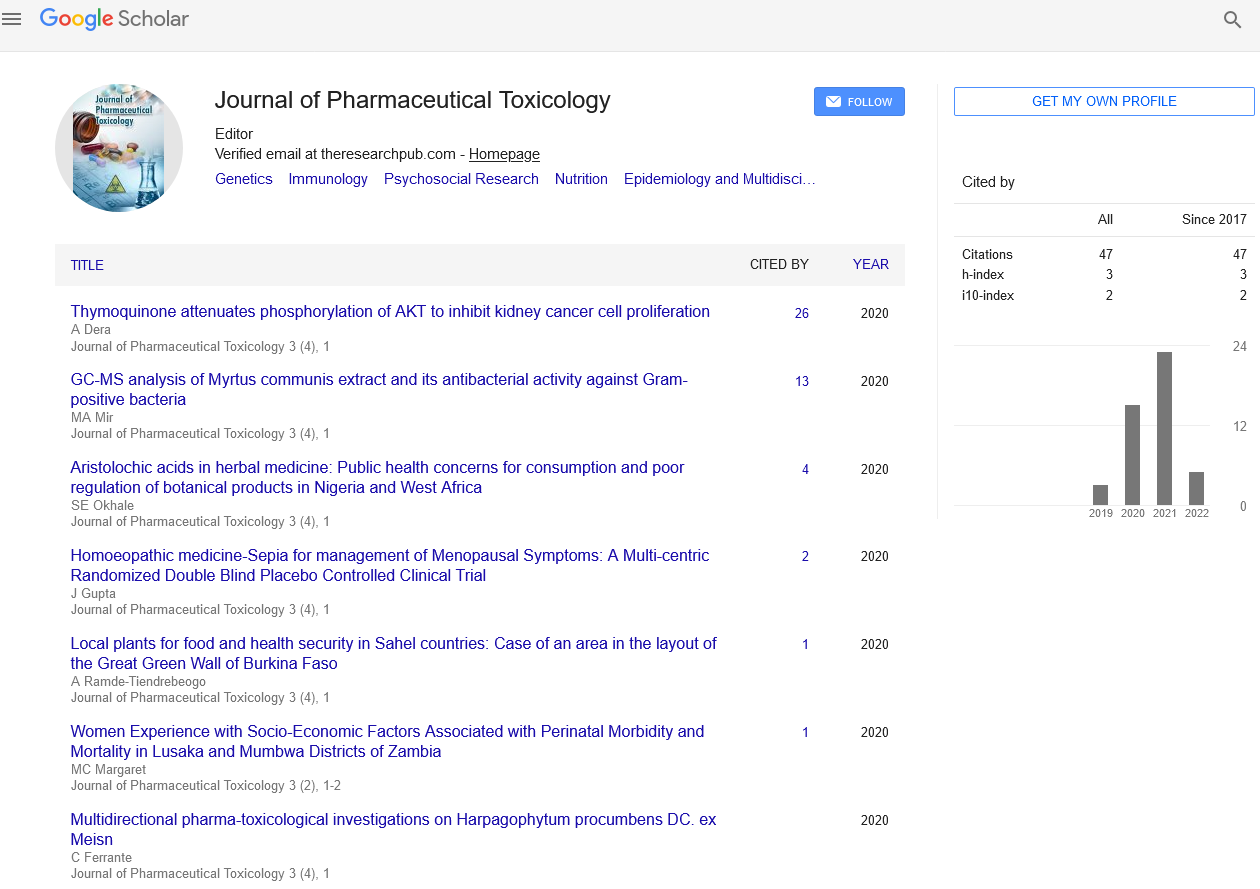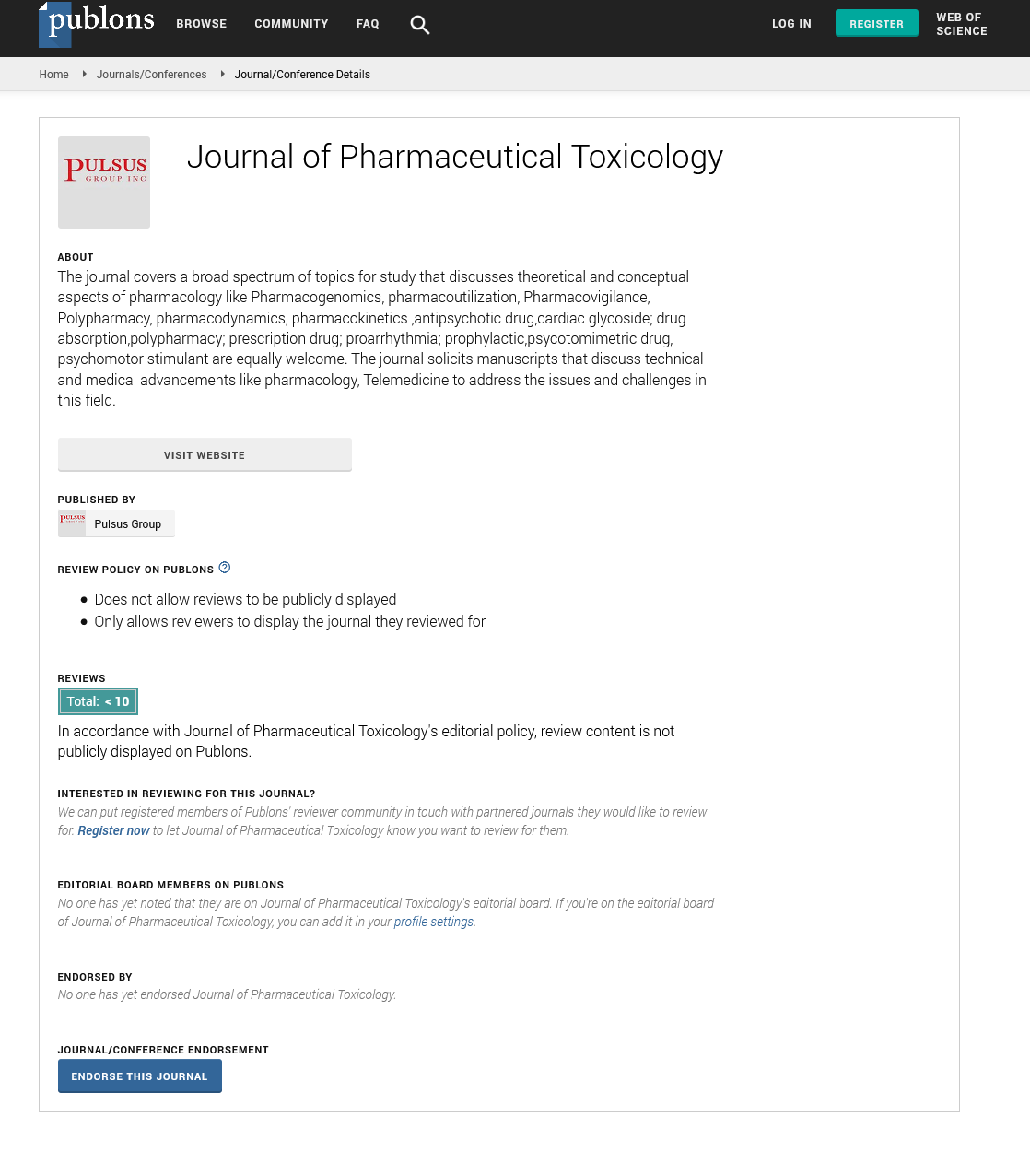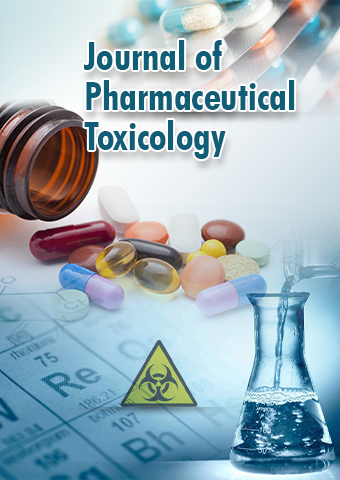Short Communication - Journal of Pharmaceutical Toxicology (2023) Volume 6, Issue 3
Revolutionizing Pharmaceutical Industry: Advances in Drug Delivery Systems
Kazuo Nakamura*
Department of Biopharmaceutics, Nihon Pharmaceutical University, Japan
- *Corresponding Author:
- Kazuo Nakamura
Department of Biopharmaceutics, Nihon Pharmaceutical University, Japan
E-mail: nakamura_kn@gmail.
Abstract
Introduction
The pharmaceutical industry is experiencing a transformative shift with significant advancements in drug delivery systems. These innovative technologies are revolutionizing the way medicines are administered, enhancing their efficacy, safety, and patient compliance. By overcoming various challenges associated with traditional drug delivery methods, these breakthroughs hold tremendous potential to improve patient outcomes and transform the treatment landscape. This article explores some of the remarkable developments in drug delivery systems that are reshaping the pharmaceutical industry. Nanotechnology has emerged as a game-changer in drug delivery, allowing precise targeting and controlled release of therapeutic agents. Nanoparticles, liposomes, and nanoscale polymer systems enable efficient drug delivery to specific tissues or cells, enhancing therapeutic effectiveness while minimizing side effects. Researchers are exploring various nanotechnology-based strategies, such as targeted drug delivery to tumors, crossing the blood-brain barrier, and personalized medicine tailored to individual patient profiles [1-3].
The rapid advancements in personalized medicine are transforming the pharmaceutical industry by shifting the focus from a one-size-fits-all approach to tailored treatments. By incorporating genomics, companion diagnostics, AI, ML, TDM, and digital health technologies, pharmaceutical companies are paving the way for safer, more effective medications. Personalized medicine holds immense promise for improving patient outcomes, reducing healthcare costs, and fostering a new era of precision healthcare. As research and technological innovations continue to unfold, personalized medicine is poised to revolutionize the future of pharmaceuticals.
Implantable drug delivery devices offer a promising solution for long-term treatment of chronic conditions. These devices are designed to release medications gradually over an extended period, eliminating the need for frequent dosing and improving patient compliance. Implantable devices can be used for conditions like diabetes, chronic pain, and hormonal disorders, providing a continuous and controlled release of drugs while reducing fluctuations in drug levels. Gene therapy and RNA-based therapeutics have gained considerable attention for their potential to target specific genetic disorders. Recent advancements in these fields have paved the way for highly targeted drug delivery systems. Viral vectors and non-viral delivery methods are being explored to safely and efficiently deliver therapeutic genes or RNA molecules into the patient’s cells, offering the possibility of treating previously untreatable diseases at the genetic level [4,5].
Additive manufacturing, commonly known as 3D printing, has extended its reach to pharmaceuticals. This technology enables the creation of personalized, patient-specific medications with complex drug release profiles. 3D-printed medications can be tailored to individual patient needs, incorporating multiple drugs or dosages into a single tablet. This approach has the potential to revolutionize drug manufacturing, improve medication adherence, and enhance patient outcomes.
Discussion
Smart drug delivery systems combine sensor technology, data analytics, and connectivity to provide personalized and precise drug administration. These systems can monitor patient response, adjust dosages, and transmit real-time data to healthcare providers. By enabling real-time tracking of drug levels in the body and tailoring treatment regimens accordingly, smart drug delivery systems enhance therapeutic effectiveness while minimizing adverse effects. Advancements in drug delivery systems are propelling the pharmaceutical industry into a new era of personalized and targeted medicine. Nanotechnology, implantable devices, gene therapy, 3D printing, and smart drug delivery systems are among the remarkable innovations transforming how drugs are delivered to patients. These breakthroughs hold immense promise for improving treatment outcomes, reducing side effects, and enhancing patient convenience and compliance. As research and development continue, the future of drug delivery systems looks incredibly promising, revolutionizing the way we approach healthcare and paving the way for more effective and precise treatments [6,7].
Personalized medicine, also known as precision medicine, is revolutionizing the field of healthcare and pharmaceuticals. This innovative approach tailors medical treatments to an individual’s unique characteristics, including their genetic makeup, lifestyle, and environment. By leveraging cutting-edge technologies and genomic research, personalized medicine holds the promise of improving patient outcomes, reducing adverse reactions, and optimizing drug development. In this article, we will explore the recent advancements in personalized medicine and its transformative impact on the pharmaceutical industry. Advancements in genomics have paved the way for personalized medicine. Genomic medicine involves the analysis of an individual’s genetic information to identify specific genetic variations associated with diseases and drug responses. Pharmacogenomics, a subset of genomic medicine, focuses on understanding how an individual’s genetic makeup influences their response to medications. Pharmaceutical companies are increasingly incorporating pharmacogenomic data into drug development processes to create tailored treatments that maximize efficacy while minimizing adverse reactions.
Companion diagnostics are diagnostic tests that help identify patients who are most likely to benefit from a particular treatment or medication. These tests analyze biomarkers or genetic markers to determine a patient’s suitability for a specific therapy. By enabling targeted treatments, companion diagnostics enhance patient selection and improve overall treatment outcomes. Pharmaceutical companies are collaborating with diagnostic companies to develop companion diagnostics alongside new drug approvals, facilitating personalized treatment plans.
AI and ML are revolutionizing various industries, including pharmaceuticals. These technologies are being employed to analyze large datasets, identify patterns, and extract meaningful insights. In personalized medicine, AI and ML algorithms are used to analyze complex patient data, including genomic information, electronic health records, and real-time monitoring data. This helps identify personalized treatment options, predict disease outcomes, and optimize drug dosages based on individual characteristics [8-10].
Conclusion
Therapeutic drug monitoring involves measuring drug levels in a patient’s blood to ensure optimal dosing and avoid toxicity. Personalized medicine utilizes TDM to tailor drug dosages to individual patients, taking into account factors such as metabolism, drug interactions, and genetic variations. Pharmaceutical companies are investing in research and development to incorporate TDM strategies into drug formulations and treatment protocols, leading to safer and more effective medications. Personalized medicine places a significant emphasis on patient engagement and empowerment. Digital health technologies, such as wearable devices, mobile apps, and telemedicine, enable continuous monitoring, remote consultations, and real-time feedback. These tools facilitate the collection of patient-generated health data, promoting a deeper understanding of individual health profiles. Pharmaceutical companies are leveraging digital health platforms to gather patient insights, conduct clinical trials, and refine personalized treatment strategies.
Acknowledgement
None
Conflict of Interest
None
References
- Van den Anker J, Reed MD, Allegaert K et al. Developmental Changes in Pharmacokinetics and Pharmacodynamics. J Clin Pharmacol. 58, 10-25 (2018).
- Aagaard L. Off-Label and Unlicensed Prescribing of Medicines in Paediatric Populations: Occurrence and Safety Aspects. Clin Pharmacol Toxicol. 117, 215–218(2015).
- Gore R, Chugh PK, Tripathi CD. Pediatric Off-Label and Unlicensed Drug Use and Its Implications. Curr Clin Pharmacol.12, 18–25 (2018).
- Sketris, IS. American Geriatrics Society Beers Criteria® Update Expert Panel. American Geriatrics Society 2019 Updated AGS Beers Criteria® for Potentially Inappropriate Medication Use in Older Adults. J Am Geriatr Soc. 67, 674–694 (2019).
- Hill-Taylor B, Walsh KA, Stewart S et al. Effectiveness of the STOPP/START (Screening Tool of Older Persons’ potentially inappropriate Prescriptions/Screening Tool to Alert doctors to the Right Treatment) criteria: Systematic review and meta-analysis of randomized controlled studies. JClin PharmTher. 41, 158–169 (2016).
- Tommelein E, Mehuys E, Petrovic M et al. Potentially inappropriate prescribing in community-dwelling older people across Europe: A systematic literature review. Eur J Clin Pharmacol. 71, 1415–1427.
- Prot-Labarthe S, Weil T, Angoulvant F et al. POPI (Pediatrics: Omission of Prescriptions and Inappropriate prescriptions): Development of a tool to identify inappropriate prescribing. PLoS ONE. 9,25-68.
- Corrick F, Conroy S, Sammons H et al. Paediatric Rational Prescribing: A Systematic Review of Assessment Tools. Int J Environ Res Public Health. 17, 1473-1496 (2015).
- Sadozai L, Sable S, Le E Roux et al. International consensus validation of the POPI tool (Pediatrics: Omission of Prescriptions and Inappropriate prescriptions) to identify inappropriate prescribing in pediatrics. PLoS ONE .15, 47-72 (2018).
- Barry E, Moriarty F, Boland F et al. The PIPc Study-application of indicators of potentially inappropriate prescribing in children (PIPc) to a national prescribing database in Ireland: A cross-sectional prevalence study. BMJ Open. 8, 69-556 (2019).
Indexed at, Google Scholar, Cross ref
Indexed at, Google Scholar, Cross ref
Indexed at, Google Scholar, Cross ref
Indexed at, Google Scholar, Cross ref
Indexed at, Google Scholar, Cross ref
Indexed at, Google Scholar, Cross ref


